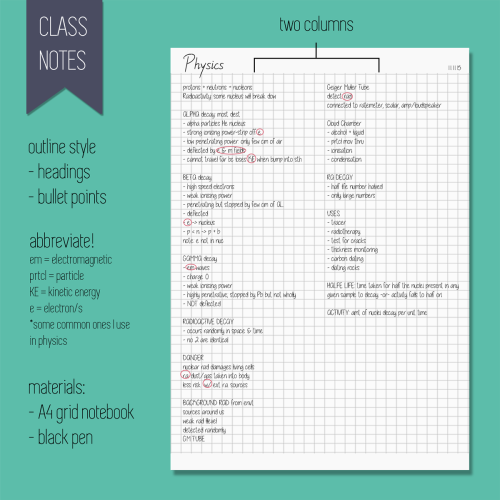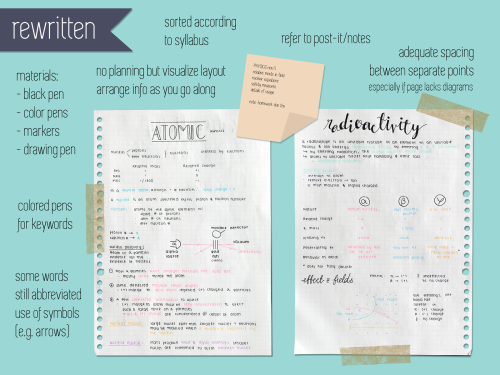eintsein:Note-Taking Hey guys! So I’ve been receiving questions regarding my note-taking sty
eintsein: Note-Taking Hey guys! So I’ve been receiving questions regarding my note-taking style and strategy for quite some time now but I believe I have never answered them in detail. The good news is, I finally decided to make a post about this (plus, I had fun making the graphics :D). Note that I am a visual learner, so my note-taking methods may not be effective for some of you, but I hope you can all learn something. Class Notes I only use one notebook for all my class notes, an A4 grid notebook whose pages I divide into two columns. I use the outline method for in-class notes, which means I write information chronologically, in the order that they are taught. Some teachers do not have properly structured presentations/lessons (good thing my physics teacher does) so when in need, I use arrows to connect related information. Abbreviations to me are one of the most important things to master when taking notes. I personally make them up as I go along. Some examples of abbreviations I use are: w/c - which w/ - with cpd - compound envt - environment digenz - digestive enzyme It might be confusing, but to me, knowing the context and part of speech are enough for all abbreviations to be comprehended. Here’s an example: ‘Indonesia’s tsunami pre-warning system is made up of two types of components’ could become ‘Indo’s snmi pre-warn sys 2 type comp’. After Class The first thing I would do is highlight keywords and terminology (and sometimes formulas). For physics, since my teacher is relatively succinct, I don’t really highlight, but for humanities and biology, I look for words that would be expected by a mark scheme, words that are crucial to the understanding of each particular piece of information. I would then check if the material taught coincides with the syllabus, and if not, note down any points that are missing or have yet to be taught. You could write these on a post it or on the syllabus itself, but I prefer to highlight the syllabus’ pdf file. Rewritten Notes My rewritten notes are arranged based on the order they appear in the syllabus unless there are pieces of information that are related to more than one topic. I use a black pen for rewriting notes as well as colored pens to write keywords and terminology only. I know some people who write whole sentences in colored pens but to me that is ineffective; we all have our own learning styles. When making tables, I usually use different colors for different columns (see the table for different types of radiation above) which is most often the color I associate with each word. For example, water would be blue, ocean would be a darker shade, ice would be a lighter shade, and water vapor would be purple. I still abbreviate words in my rewritten notes, but they’re not as condensed as the ones in my class notes. Another thing I find helpful is leaving a bit of space between separate points especially if the page doesn’t have a lot of diagrams. I can’t think linearly, so I can’t remember super lengthy bullet points. I use mildliners and a drawing pen to make my diagrams (more of these in my biology notes) but I only start with pencil if it’s a complex diagram. I rarely highlight my rewritten notes, but even if I do, it’s usually only the headings and formulas. I don’t have a rough draft for my notes, but I try to visualize the layout. I try to alternate between words and pictures/diagrams so that when I’m sitting for an exam, all I have to do is imagine that I’m looking at that page and I can remember where everything is. Well, that’s all from me. I hope that this information could be of some use to every single one of you. Don’t hesitate to ask me questions if you’re confused about note-taking or any other problems you might have :) -- source link
Tumblr Blog : www.eintsein.com
#masterpost



